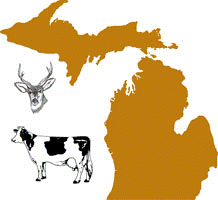Wildlife Disease and Zoonotics
Date of this Version
2009
Abstract
Wildlife reservoirs of Mycobacterium bovis represent serious obstacles to the eradication of tuberculosis in domestic livestock and the cause for many faltering bovine tuberculosis eradication programs. One approach in dealing with wildlife reservoirs of disease is to interrupt inter-species and intraspecies transmission through vaccination of deer or cattle. To evaluate the efficacy of BCG vaccination in white-tailed deer, 35 deer were assigned to one of three groups; one s.c. dose of 107 CFU of M. bovis BCG Pasteur (n = 12); 1 s.c. dose of 107 CFU of M. bovis BCG Danish (n = 11); or unvaccinated deer (n = 12). After vaccination, deer were inoculated intratonsilarly with virulent M. bovis. Lesion severity scores of the medial retropharyngeal lymph node, as well as all lymph nodes combined, were reduced in vaccinated deer compared to unvaccinated deer. BCG Danish vaccinated deer had no late stage granulomas characterized by coalescent caseonecrotic granulomas containing numerous acid-fast bacilli compared to BCG Pasteur vaccinated or unvaccinated deer where such lesions were present. Both BCG strains were isolated as late as 250 days after vaccination from deer that were vaccinated but not challenged. In white-tailed deer, BCG provides protection against challenge with virulent M. bovis. Issues related to vaccine persistence, safety and shedding remain to be further investigated.



Comments
Published in Zoonoses Public Health 56 (2009) 243–251.